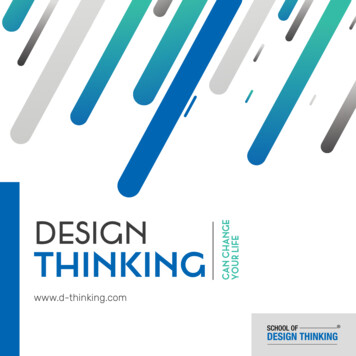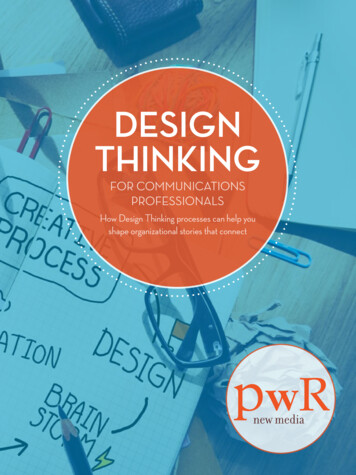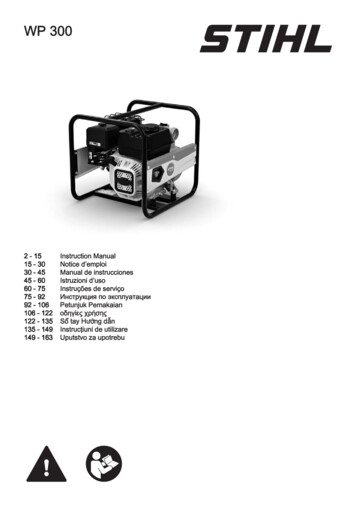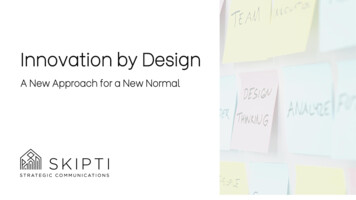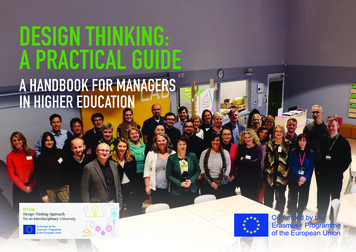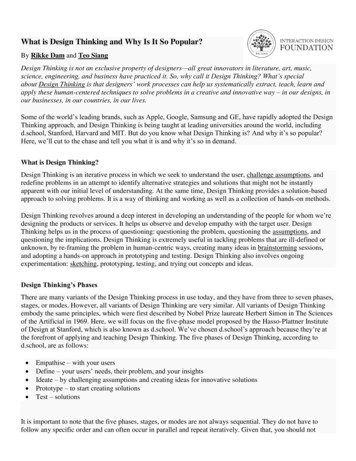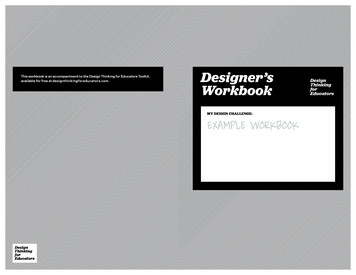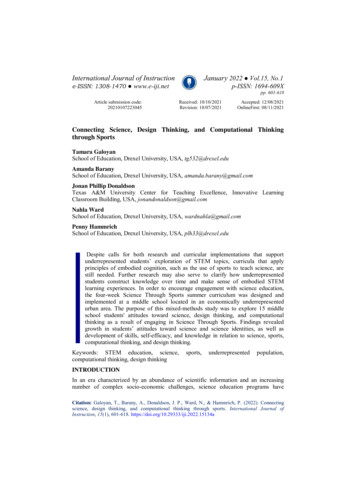
Transcription
International Journal of InstructionJanuary 2022 Vol.15, No.1e-ISSN: 1308-1470 www.e-iji.netArticle submission code:20210107223045p-ISSN: 1694-609Xpp. 601-618Received: 10/10/2021Revision: 18/07/2021Accepted: 12/08/2021OnlineFirst: 08/11/2021Connecting Science, Design Thinking, and Computational Thinkingthrough SportsTamara GaloyanSchool of Education, Drexel University, USA, tg532@drexel.eduAmanda BaranySchool of Education, Drexel University, USA, amanda.barany@gmail.comJonan Phillip DonaldsonTexas A&M University Center for Teaching Excellence, Innovative LearningClassroom Building, USA, jonandonaldson@gmail.comNahla WardSchool of Education, Drexel University, USA, wardnahla@gmail.comPenny HammrichSchool of Education, Drexel University, USA, plh33@drexel.eduDespite calls for both research and curricular implementations that supportunderrepresented students’ exploration of STEM topics, curricula that applyprinciples of embodied cognition, such as the use of sports to teach science, arestill needed. Further research may also serve to clarify how underrepresentedstudents construct knowledge over time and make sense of embodied STEMlearning experiences. In order to encourage engagement with science education,the four-week Science Through Sports summer curriculum was designed andimplemented at a middle school located in an economically underrepresentedurban area. The purpose of this mixed-methods study was to explore 15 middleschool students' attitudes toward science, design thinking, and computationalthinking as a result of engaging in Science Through Sports. Findings revealedgrowth in students’ attitudes toward science and science identities, as well asdevelopment of skills, self-efficacy, and knowledge in relation to science, sports,computational thinking, and design thinking.Keywords: STEM education, science,computational thinking, design TIONIn an era characterized by an abundance of scientific information and an increasingnumber of complex socio-economic challenges, science education programs haveCitation: Galoyan, T., Barany, A., Donaldson, J. P., Ward, N., & Hammrich, P. (2022). Connectingscience, design thinking, and computational thinking through sports. International Journal ofInstruction, 15(1), 601-618. https://doi.org/10.29333/iji.2022.15134a
602Connecting Science, Design Thinking, and Computational emerged as particularly critical for the development of essential knowledge, skills, andattitudes that can help learners from underrepresented minority populations engage moredeeply with science, technology, engineering and mathematics (STEM). As emphasizedby policy documents, to be able to face this “new explosion of scientific knowledge”,science education curricula should continue to change in “radical ways” (Organizationfor Economic Cooperation and Development, 2018, p. 4). According to the NationalAcademies of Sciences, Engineering, and Medicine (2019), middle school scienceinvestigations and engineering practices should be viewed as a social endeavor, allowingstudents to make connections between science and engineering concepts, applycomputational thinking and design thinking principles, and integrate those concepts andprinciples into their own ideas and experiences.In this work, we define learning as a simultaneous process of becoming and constructionof meaning (Donaldson & Allen-Handy, 2019). Learning environments with thisontological perspective in mind hold potential for supporting students’ engagement,interests and motivation (Eccles, 2009; Järvelä & Renninger, 2014), particularly whenthey are designed to encourage the exploration and enactment of relevant identities(Foster, Shah, Barany & Talafian, 2019). As such, tapping into learner interest andmotivation has potential to impact not only the learning at hand, but also transfer oflearning and long-term academic and career trajectories (Galoyan & Betts, 2021; Kaplan& Garner, 2017; Perez et al., 2014). Embodied modalities of learning, such as learningactivities designed to integrate embodied cognition in body-based activities in whichphysical and social contexts mediate learning (Nathan & Sawyer, 2014), hold particularvalue in this context. Emerging literature on the processes of embodied cognition shiftemphasis towards learning as a lived experience, which is embodied not only throughinteraction with objects (e.g., science and computational tools, sports materials), but alsoembodied through interaction with other individuals and groups (e.g., studentscollaboratively exploring science through the medium of sports) (Astutik & Susantini,2020; Vossoughi et al., 2020). This view is supported by educational best practices,including the Next Generation Science Standards (NGSS) grounded in the principles ofscience, engineering design, and computational thinking (National Research Council(NRC), 2012). Research highlights the connection between science and computationalthinking by viewing science as a computational endeavour and computational thinkingas a core scientific practice (Weintrop et al., 2016, NRC, 2012). The use ofcomputational skills and tools in science classrooms encourages student awareness ofscience concepts and may help prepare students to pursue related careers in the future(Weintrop et al., 2016; Augustine, 2005; NRC, 2012). Engineering design and designthinking have also been emphasized as core practices for enhancing science learningthrough hands-on activities and meaningful social interactions (Kanadli, 2019; Galoyanet al., 2019; NRC, 2012; Pratomo & Wardani, 2021).The use of sports and sports education as a vehicle for encouraging engagement andlearning around science topics has both research and applied precedent (Donaldson &Hammrich, 2016), but has yet to employ embodied cognition principles in design orimplementation. In the authors’ prior research, a science through sports implementationwas found to encourage STEM participation and engagement among female studentsInternational Journal of Instruction, January 2022 Vol.15, No.1
Galoyan, Barany, Donaldson, Ward & Hammrich603(Hammrich et al., 2001; Hammrich et al., 2003). Given the success of suchprogramming among female students, expansion of such curricula to economically andracially underrepresented student populations was identified as a potentially valuableendeavor.While other science through sports research and applications exist (e.g., PizzanoMiraglia & Miraglia, 2013; Ropchock, 2019), they lack grounding in robust theories oflearning such as embodied cognition or constructionism. Given the paucity oftheoretically grounded science through sports curricula, new implementations thatleverage theories of constructionism and embodied cognition are still needed. Appliedand theoretical questions also remain, such as (1) how a science through sports programmay be optimally designed and implemented leveraging both educational best practicesand existing theories of embodied and constructivist learning to encourage STEMparticipation among underrepresented groups, and (2) how underrepresented studentsconstruct knowledge over time and make sense of these embodied STEM learningexperiences.Our Science Through Sports curriculum used embodied experiences through whichunderrepresented middle school students in an urban context engaged with and applied(1) computational, scientific, and design thinking skills, (2) science knowledge andconcepts, (3) increasingly sophisticated worldviews regarding the nature of science, and(4) identification with computing and scientific communities of practice. This programaimed to address the challenges continuously experienced by Black students withinPhiladelphia’s Promise Neighborhood zone with regards to academic performance andaccess to academic resources (Maranto et al., 2016; The White House, 2014). To alignwith educational best practices, the program curriculum was grounded in the NGSS(NRC, 2012) and K-12 Computer Science Frameworks (K-12 Computer Science(K12CS) Framework, 2016). The NGSS Framework provides developmentallyappropriate standards for science learning and has been widely used for improving thequality of science teaching and learning (e.g., Dalvi, Silva Mangiante, & Wendell, 2021;Rachmawati, Prodjosantoso, & Wilujeng, 2019). The K12CS Framework does the samefor computer science, with an emphasis on computational thinking. Both frameworkscontain crosscutting concepts that connect disciplinary practices to core ideas.The goal of this study was two-fold: (1) to design and implement a four-week ScienceThrough Sports curriculum with middle school science students; and (2) to investigatethe impact of the curriculum in relation to the following research question: What are theperceptions of science, design thinking, and computational thinking amongunderrepresented middle school students who participated in the Science ThroughSports curriculum?Science Through Sports CurriculumThe curriculum was designed by the study researchers in collaboration with a middleschool science teacher who subsequently helped with curricular implementation withmiddle school students as part of the Science Through Sports summer program. Thecurriculum design was guided by the Next Generation Science Standards (NGSS) andInternational Journal of Instruction, January 2022 Vol.15, No.1
604Connecting Science, Design Thinking, and Computational the K-12 Computer Science (K12CS) frameworks. The program consisted of eightlessons implemented across four weeks, and each lesson was planned for three hours ofinstruction with a 30-minute lunch break.As shown in Table 1, the curriculum was designed around two NGSS-aligned anchorgoals which combined elements of three-dimensional (3D) learning: (1) science andengineering practice (SEP), (2) disciplinary core idea (DCI), and (3) cross-cuttingconcepts (CCC), as outlined by the Framework for K-12 Science Education (NationalResearch Council, 2012). As illustrated in Table 2, each lesson was designed to addressthese broader anchor goals through integration of science and sports topics, as well asdesign thinking and computational thinking principles. Sports and science activitieswere developed by adopting and adapting curricular materials from prior sports scienceimplementations in other learning contexts (Hammrich et al., 2001; Hammrich et al.,2003). The design thinking activities were structured by the Design Thinking forEngaged Learning (DTEL) model (Donaldson & Smith, 2017) which can be used toguide students through five phases of the design thinking process: 1) Name and Frame,2) Diverge and Converge, 3) Prepare and Share, 4) Analyze and Revise, and 5) Deploy.These phases are further broken down into ten steps and encourage learners to practicedesign skills such as problem framing, ideation, low-fidelity prototyping, high-fidelityprototyping, evaluating prototypes, and refining prototypes.Table 1Next generation science standards (NGSS) guiding science through sports curriculumdesignNGSS Anchor GoalsThree-Dimensional LearningMS-PS2-1: Apply Newton’s Third Law todesign a solution to a problem involving themotion of two colliding objectsSEP:ConstructingExplanationsDesigning SolutionsDCI: PS2.A - Forces and MotionCCC: Systems and System ModelsandMS-PS2-2: Plan an investigation to provideevidence that the change in an object’smotion depends on the sum of the forces onthe object and the mass of the objectSEP:PlanningandCarryingInvestigationsDCI: PS2.A - Forces and MotionCCC: Stability and ChangeOutInternational Journal of Instruction, January 2022 Vol.15, No.1
Galoyan, Barany, Donaldson, Ward & HammrichTable 2Science through sports curriculum overviewWeekLessonWeek 1Lesson 1Lesson 2Lesson 3Lesson 4Week 2Week 3Lesson 5SportsTopicSoccerTrack andFieldBasketballLesson 6Week 4Lesson 7Lesson 8BasketballScience TopicMotionAnglesAverage speedPulse rate andbreathing rateAccelerationand decelerationMomentumVelocitySpeed and rate605Design ThinkingPrincipleProblem framingComputationalThinking PracticeIdeationPractice 3:Recognizing ypingHigh-fidelityprototypingEvaluating prototype(analyzing data)Refining prototype(final iteration)Practice 7:Communicatingabout the problemUnlike traditional curricula that may unduly emphasize the learning of disconnectedconcepts and rote memorization (National Research Council, 2000), the ScienceThrough Sports curriculum combines conceptual understandings of science with sportsand practical skills to support active learning, critical thinking, and collaborativeproblem-solving. For example, in Lesson 1, after a brief introduction and a warm-upactivity, the students spent the first hour outside playing soccer. They then returned tothe classroom to explore the scientific concept of motion through a discussion, makingexplicit connections to the soccer game. Next, they applied their knowledge of motion toa hands-on science activity where they collaboratively built a roller coaster to test theprinciples of motion. The lesson ended with students enacting the first stage of the fivestep design thinking cycle in which they worked in groups of 3-4 to identify a designproblem they could address in the next few weeks by applying the principles of science,sports, computational thinking, and design thinking (see Figure 1).Figure 1Students designing a roller coaster (left) and Ideating (right)METHODResearch DesignThis study used a convergent mixed methods design to investigate howunderrepresented students construct knowledge over time and make sense of theirInternational Journal of Instruction, January 2022 Vol.15, No.1
606Connecting Science, Design Thinking, and Computational embodied STEM learning experiences. This type of design allowed for concurrentcollection and analysis of both quantitative and qualitative data and merging the findingsto gain a complementary and holistic understanding of the issue (Creswell & PlanoClark, 2017; Tashakkori & Teddlie, 1998; 2003).Setting and Target PopulationThe target population consisted of students at a middle school located in an urbanneighborhood that has been designated an urban Promise Zone that housed primarilyBlack residents. In 2014, Promise Zones were identified by the Obama administration asareas in need of coordinated initiatives that could attract resources to economicallychallenged and underserved populations that faced persistent poverty (The WhiteHouse, 2014). Students from Promise Zone neighborhood schools have consistentlydemonstrated patterns of academic underperformance (Maranto et al., 2016). The ratesof poverty, housing vacancy, and crime in the area are relatively high compared to bothnational averages and to other residential districts in the city (Mayor’s Office ofCommunity Empowerment and Opportunity (CEO)). Nonetheless, the community boastsvibrant cultural and community resources as well accessible anchor institutions(including the local school in which the summer camp was implemented) andtransportation resources, making the location ideal for education, public safety, housing,economic opportunity, and health and wellness initiatives (CEO). Procedures for siteaccess, student recruitment, parental assent, and student consent were designed andapproved by the Institutional Review Board through the researchers’ university.ParticipantsOverall, 15 middle school students participated in the Science Through Sports summerprogram. Of the 15 students, 11 (73 % males and 27% females) volunteers participatedin the quantitative strand of this mixed methods study by completing a pre- and postsurvey. The same 11 students and their teacher also participated in the qualitative strandof the study, with 30-minute semi-structured interviews. The participants ranged fromages 10 to 13, and the majority (82%) self-identified as Black or African American.InstrumentsQuantitative data was collected through a 51-item participant survey administeredbefore and after the program. The survey consisted of three sections: (1) DemographicInformation, (2) Attitudes towards Science and Science Identity, and (3) Attitudestowards Computer Use and Computing. Section 2 and Section 3 were measured on a 6point Likert-style scale (strongly disagree to strongly agree). Section 2 included 34items adapted from the Self-determination, Purpose, Identity, and Engagement inScience (SPIRES) survey (Skinner et al., 2017). Section 3 included ten items adaptedfrom the Attitudes Towards Computer Science (ATCS) survey (Hoegh & Moskal,2009). Both scales from the original surveys were modified for language, grammar, andoverall clarity to make it accessible for the target age group.Qualitative data was collected through semi-structured interviews with the students. Thestudent interview protocol (see Appendix A) was designed by the researchers of thisInternational Journal of Instruction, January 2022 Vol.15, No.1
Galoyan, Barany, Donaldson, Ward & Hammrich607study and consisted of 14 open-ended questions related to students’ perceptions andattitudes towards the Science Through Sports curriculum. Some questions asked aboutwhat students found interesting or enjoyable, both during each weekly meeting (e.g.,What was your favorite activity?) and in general (e.g., Do you like sports?). Questionsalso asked students to elaborate on their experiences with curricular activities (e.g.,What problems were you working on today? What was the solution?) and processes theyenacted (e.g., What was the most challenging activity? How did you overcome thechallenge?). Finally, questions prompted students to reflect on specific topics covered inthe curriculum such as identity (e.g., Would you like to become a scientist/athlete in thefuture? Why or why not?), design thinking (e.g., What are the most important things toconsider when you design something?), computational thinking (e.g., What do you usecomputers for?), and connections between science and sports (e.g., How do you thinksports is related to science?). The interview concluded by asking students to offer ideasfor new activities or improvements in future camp iterations (e.g., What other activitieswould you like to do?).Data AnalysisParticipant SurveySurvey data was analyzed using the IBM SPSS Statistics 26 software tool. Researchersbegan analysis by screening the data for missing values (Garson 2015). This wasfollowed by applying the reverse scoring technique for the negative statements in bothSection 2 and Section 3. Internal consistency of the scales was assessed by running theCronbach’s alpha with a threshold of α .70 (Taber, 2018). Next, Paired-samples t-testswere performed on overall and individual pre- and post-survey items to compare meansbetween the pre- and post-surveys. This was intended to account for changes in students’attitudes toward science and science identity and attitudes towards computer use andcomputing. The level of significance was set at . 05.InterviewsThe analysis of the interview data involved qualitative case study methods (Merriam &Tisdell, 2016) with aspects of grounded theory such as open coding and axial coding(Corbin & Strauss, 2015). The interviews were transcribed and entered into theMAXQDA Pro qualitative analysis software. Three researchers independentlyconducted open coding of all interviews, after which they compared codebooks andnegotiated a final codebook consisting of 120 codes in 14 categories. Complex systemsmethodologies of correlational and semantic network analysis methods (Donaldson,2019; Jacobson & Kapur, 2012; Lü et al., 2016) were used in the axial coding stage.Matrices were produced in which cells contained information about the correlationbetween every pair of codes indicating the likelihood that both codes appeared in thesame interview. The correlation matrices were imported into the UCINET networkanalysis software (Borgatti et al., 2002) as 1-mode networks and visualizations ofcorrelational models were generated using NetDraw (Borgatti, 2002) to identifypatterns. Eigenvector centrality measures were used to identify the salient themes in thereflective data, as it offers a more sophisticated understanding of semantic influence byInternational Journal of Instruction, January 2022 Vol.15, No.1
608Connecting Science, Design Thinking, and Computational first assessing connections to other semantic themes (degree centrality) and thenweighting that score based on the respective influence of those connections (Kadushin,2012). Semantic networks were weighted by betweenness centrality, which highlightsthemes that serve as bridges between other constructs. Finally, Girvan-Newman clusteranalysis (Newman & Girvan, 2004) was conducted to identify primary clusters aroundbroader themes.FINDINGSQuantitative ResultsCronbach’s AlphaTo determine the internal consistency of the participant survey, Cronbach’s alpharun for the two target constructs, namely Section 2 (Attitudes toward ScienceScience Identity) and Section 3 (Attitude toward Computer Use and Computing).analysis showed that, the Cronbach’s alpha for both constructs was greater thanindicating high internal consistency coefficients for the items (Taber, 2018).wasandThe.70,Paired-Sample T-TestsPre- and post-survey results for Section 2 and Section 3 were compared using pairedsamples t-tests to measure the change in students’ attitudes over time. For Section 2,there was a statistically significant difference [t(10) -4.298, p .002, two-tailed]between the mean scores for the pre- (M 4.460, SD .497) and post-surveys (M 4.808,SD .469), indicating an increased positive attitude toward science and science identity.There were no statistically significant differences in the overall mean scores for Section3. However, there was an increase in the mean scores from the pre- (M 5.027,SD .687) to post-surveys (M 5.336, SD .459) (Table 3). Similarly, paired-samples ttests were run on individual items in both sections in order to compare means. Severalstatistically significant increases in the mean scores from pre- to post-test for Section 2were found. For example, there was a significant increase in students’ perceptions forItem 1: I am good at science (M (pre-) 4.18, SD (pre-) 1.33; M (post-) 4.91;SD(post) 0.7), Item 3: Even if they are challenging, I can do well in my scienceclasses (M (pre-) 4.73, SD(pre-) 1.01; M (post) 5.27, SD (post) .65), Item 25: Ifeel at home in science classes (M (pre-) 2.18, SD (pre-) 1.30; M (post) 3.09, SD(post) 1.51), and Item 30: Science can help many of society’s problems (M (pre-) 4.45, SD (pre-) .93, M(post-) 5.09, SD (post-) .94).Table 3Descriptive statistics and t-test results for pre- and post -surveysOutcomenPre-TestPost-TestMSDMSDdftSection 2344.460.4974.808.469104.298*Section 3105.027.6875.336.45910-1.631Note. *p . 05International Journal of Instruction, January 2022 Vol.15, No.1
Galoyan, Barany, Donaldson, Ward & Hammrich609Qualitative FindingsQuantitative survey responses provide insight into shifts in students’ self-perceptionsfrom the beginning to end of the Science through Sports camp. To understand how thestudents constructed knowledge and made sense of their embodied STEM learningexperiences within the Science Through Sports curriculum, key qualitative themes thatemerged in the thematic analysis of student interview data are presented to provide amore contextualized understanding of student experiences. Analysis and visualizationsof the connections between themes were created using semantic network analysis(Donaldson, 2019). Semantic networks (1) allowed for the identification of highlycentral or influential themes for each construct in the research framework that emergedin students’ discussions, and (2) illustrated key relationships between constructs asstudents described their processes.To understand how each topic relates to others in students’ discourse, betweennesscentrality measures were calculated (See Figure 2). Betweenness centrality measures thenumber of times a theme lies on the shortest path between other nodes. This helps toillustrate which qualitative themes act as bridges between other topics, highlighting theircapacity to connect each cluster to others. Figure 2 shows the semantic network in whichnode size is weighted by betweenness centrality. We identified four nodes with highbetweenness measures located as bridges between clusters. Between theExperiences/Community and Identity clusters is the Computational Thinking - Variablesbridge (betweenness 338.435). Between the Experiences/Community andMaking/Designing clusters are the Identity Exploration - Accepted Identity: FutureSports Participation bridge (betweenness 340.945) and the Design Thinking Stage 2 DivergeandConvergebridge (betweenness 242.943). Between theExperiences/Community and Learning clusters is the Affect, Emotion - Enjoyment,Liking, Fun bridge (betweenness 220.92).Figure 2Semantic network weighted by betweenness centrality showing topics that serve asbridgesComputational ThinkingThe most central themes that emerged in students’ discussions of computational thinkingprocesses were related to Collecting Data (eigenvector 0.201) and Using ComputationalInternational Journal of Instruction, January 2022 Vol.15, No.1
610Connecting Science, Design Thinking, and Computational Technologies (eigenvector 0.071). Students reflected on the process of Collecting Dataas part of their goal setting and as part of the process of problem solving and design.Often these discussions involved explicit mention of computational tools such as a timer(e.g., “timing how fast the marble goes”) and ruler (e.g., “I used the ruler after thefrog landed, I would trace it.”). Students also discussed the process of creating and usingcomputational technologies in their projects. For example, one student wrote about astop-motion app and how she learned to use it over time: “I was pressing the button, likeit would make movements, it would take pictures, it got to do different movement, and Ilearned that if we were doing it, it like create[s] movement.”Skill DevelopmentSeveral highly central themes emerged around students’ discussions of their skilldevelopment, including Identifying Challenges and Solving Problems (eigenvector0.248), Attention to Detail (eigenvector 0.268), Collaboration and Group Work(eigenvector 0.239), and Communicating and Sharing Information (eigenvector 0.212).Interviewees were readily able to detail the challenges they faced as they engaged insports science activities, as well as outline different solutions they developed to addressproblems. Challenges that students identified typically related to the limitations of theirdesign project materials (e.g., “with the roller coaster, when you was cutting the tubes,you had to cut them like a certain way to make them”) or their measurement tools (e.g.,“had to see how far it [the frog toy] would jump but the measuring stick was broke.”).Solutions typically involved changes in design or procedure to address these issues. Forexample, one student described how “I had to change the way I was putting the frog[toy] to make it jump farther.” In several cases, students described collaboration withpeers in their group work as a skill they developed to more successfully achieve theirdesign goals. For example, one student described how “we did this thing where hewould build like something to put the marble on and I would build some of that hebuilt things to hold it up and I built one.”Science LearningA key theme that emerged in students’ discussions of science learning related to thetopic of Motion (eigenvector 0.292). Though most of the curricular activities involvedfew instances of direct lecture beyond the educator explaining a few key terms andconstructs, students were readily able to identify the science topics addressed as part ofthe sports and design activities. One student described how an activity involving Legocars helped him understand the relationship between the design and the speed andvelocity of their product: “Like with the race cars, we got to experiment with the piecesand see which one would go fastest, timing with the speed and velocity.”IdentityWhile students discussed a variety of current and future identities related to science,sports, engineering, and digital technologies, the most highly central themes thatemerged connected to the group of students who affirmed interests in the Dancer role(eigenvector 0.276) and in Future Sports Participation (eigenvector 0.196). SeveralInternational Journal of Instruction, January 2022 Vol.15, No.1
Galoyan, Barany, Donaldson, Ward & Hammrich611students expressed interest in dance as a future desired identity (e.g., “I might dance be a dancer, or a dance teacher, open my own studio.”). Students with an interest indance, as well as some other students, were able to describe features of their futureparticipation in sports. Future careers such as NBA player, gymnast, or athlete wereintroduced, and some students were able to see connections between science and sportsroles (e.g., “baseball players, athletes they use things like science stuff when they’replaying baseball”), some participants viewed science and sports roles as disconnected(e.g., “I am into science but I don’t wanna be no scientist. I wanna be an athlete.”).EngagementHighly central themes related to student engagement included Design Thinking Projects(eigenvector 0.268), Happy Emotions (eigenvector 0.268) such as liking, enjoyment, orfun they experienced during participation, and descriptions of Physical Activity andMovement (eigenvector 0.276). As part of their participation in the Science ThroughSports program, students described the process of identifying problems they hoped tosolve that were related to science or sports. Design thinking questions such as “how canwe not underestimate baseball?” “How we can make dance better and getting youngand better every day” and “
2003). The design thinking activities were structured by the Design Thinking for Engaged Learning (DTEL) model (Donaldson & Smith, 2017) which can be used to guide students through five phases of the design thinking process: 1) Name and Frame, 2) Diverge and Converge, 3) Prepare and Share, 4) Analyze and Revise, and 5) Deploy.
